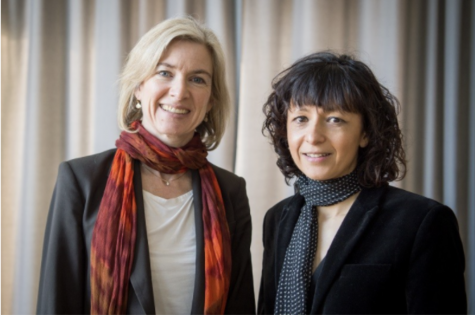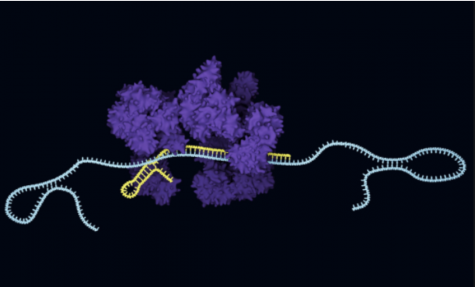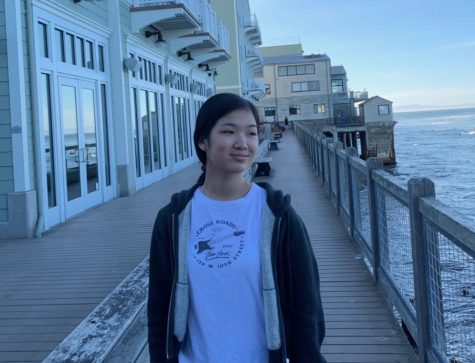The Development of CRISPR-Cas9
October 26, 2020
The 2020 Nobel Prize in Chemistry for the Development of CRISPR-Cas9
University of California, Berkeley biochemist Jennifer Doudna and her colleague Emmaneulle Charpentier, the director at the Max Planck Institute for Infection Biology, won the 2020 Nobel Peace Prize in Chemistry for their development of CRISPR-Cas9. The groundbreaking discovery and CRISPR ability have opened up various possibilities across biology, medicine, and agriculture. Dr. Doudna is the first woman on campus on the UC Berkeley faculty to win the award. Her attention was first brought on CRISPR by a UC Berkeley colleague, Jill Banfield.
In a 2012 Science paper, Doudna and Charpentier impressed the science community by showing that the Cas-9 protein was guided by tracerRNA and an RNA matching viral sequence. They realized that they could synthesize a piece of RNA that targeted and chopped any gene. The two scientists then demonstrated that this cellular defense had other implications that extended beyond killing viruses. Eight years later, after the 2012 paper, CRISPR technology was used in every aspect of biomedicine, revealing that their CRISPR visions were indeed correct.
Doudna and Charpentier were not the first to realize CRISPR’s ability; however, they were first to identify that another piece of RNA was required to bind the DNA together. The breakthrough of CRISPR has spawned legal fights with the Broad Institute at MIT over patents for the technology. Although other scientists, including Feng Zeng of the Broad, have conducted lots of research regarding the technology, the U.S. patent office recognized Doudna as the founder, awarding additional patents to UC Berkeley.

The Nobel Peace Prize recognizes works that will result in wide use. The 2020 Nobel Peace Prize award was given to Dr. Doudna and Dr. Charpentier, the sixth and seventh women in history to win a Nobel Peace Prize in chemistry. This is the first time the prize has been shared between two women, bringing hope to many other young women and girls who aspire to be like Doudna and Charpentier. The need for more women representation in sciences is crucial.
Charpentier said that she hopes that girls and young women “who would like to follow the path of science and … show them that, in principle, women in science can also be awarded prizes but, more importantly, that women in science can also have an impact through the research.”
“Many women think that, no matter what they do, their work will never be recognized the way it would be if they were a man…I think [this prize] refutes that. It makes a strong statement that women can do science, women can do chemistry, and that great science is recognized and honored,” Doudna said in a statement to UC Berkeley News.
What is CRISPR-Cas9?
CRISPR-Cas9, clusters of regularly interspaced short palindromic repeats, is a simple and powerful tool for editing genomes. It allows researchers to alter DNA sequences and modify genetic information easily. Some of its potential applications are correcting genetic mutations and defects and treating and preventing the spread of diseases. With CRISPR, researchers have said that some of its capabilities include treating blindness and advancing cancer research and treatment.
DNA contains genetic instructions for the development and function for living things. CRISPR, a revolutionizing gene-editing tool, can target specific DNA sites. Cas9 protein functions like a pair of scissors that can snip particular parts of the genome, the complete set of DNA in an organism, or insert new genetic material into our DNA. CRISPR technology is derived from the natural defense mechanisms of bacteria and archaea. These organisms within the two domains use CRISPR-derived RNA and various Cas-9 proteins to fight off viruses and other foreign substances by chopping and destroying the invader’s DNA.

Concerns About the Use of CRISPR
In 2018, CRISPR technology has become extremely popular over the last few years. It reached the headlines in news articles when Chinese scientist, He Jiankui, used the technology to create the first-ever gene-edited baby. Jiankui was jailed for three years when he announced that twin girls were born with modified DNA that made them resistant to HIV using CRISPR technology before birth. Although he was proud of his achievement, the rest of the world seemed to disagree.
Making changes to the cell in an embryo stage poses many risks and concerns. Changes to the cell can be passed on throughout generations, and there is always a possibility of imprecise edits and off-target effects. Because Jiankui genetically engineered the twins, people labeled his experiment as “monstrous” and “unethical,” creating a negative opinion of China’s biomedical research.
CRISPR has also been used in the agricultural field to engineer probiotic cultures and vaccinate industrial cultures to defend against viruses. There are many potential applications with CRISPR technology; however, scientists are not entirely confident with its efficiency. Some drawbacks and limitations must be analyzed before dominantly using this technology in various fields of study. Many researchers are now focusing on CRISPR projects, hoping to develop safe and effective CRISPR-based solutions for medicine, agriculture, and biological research.








